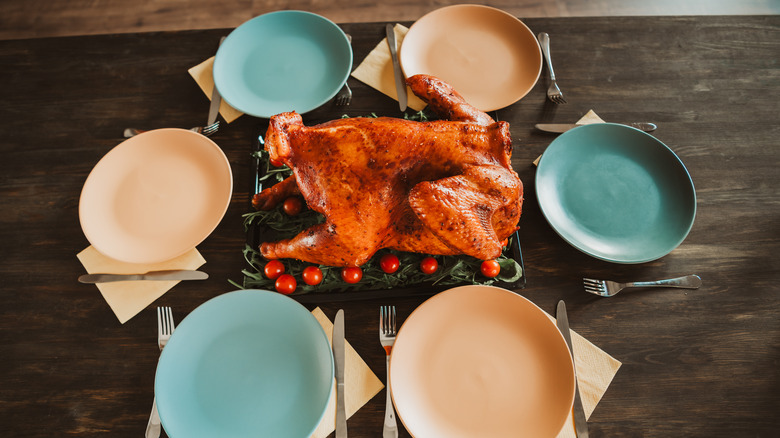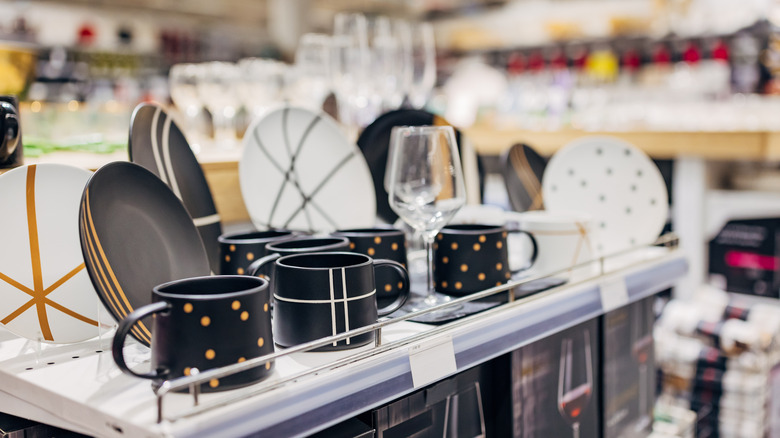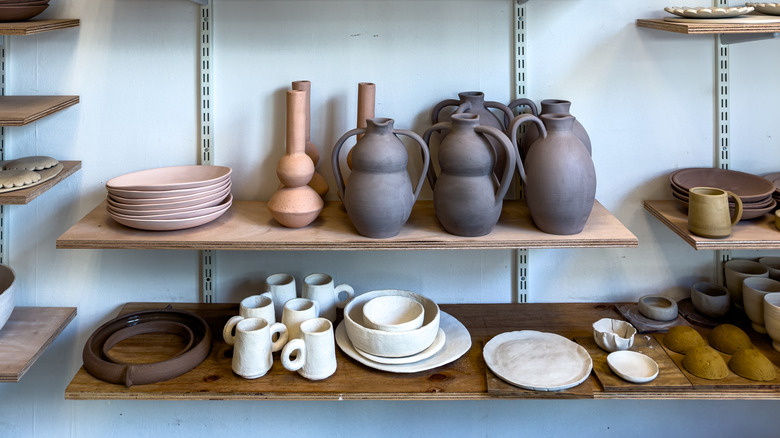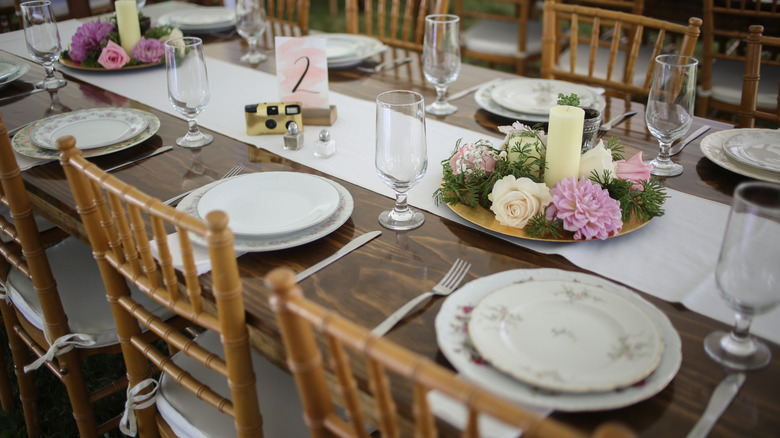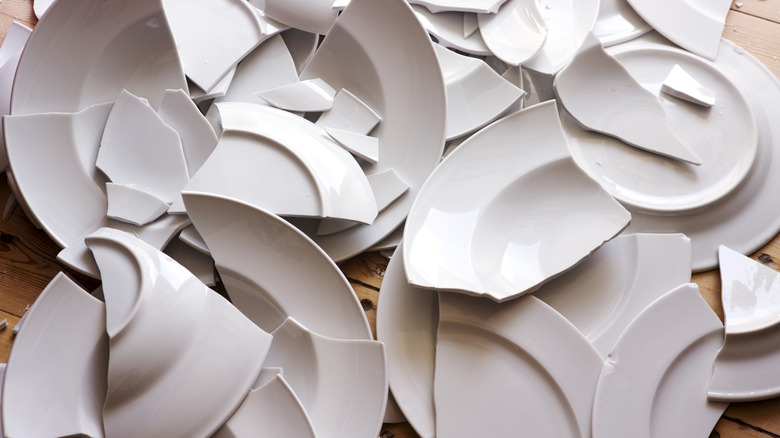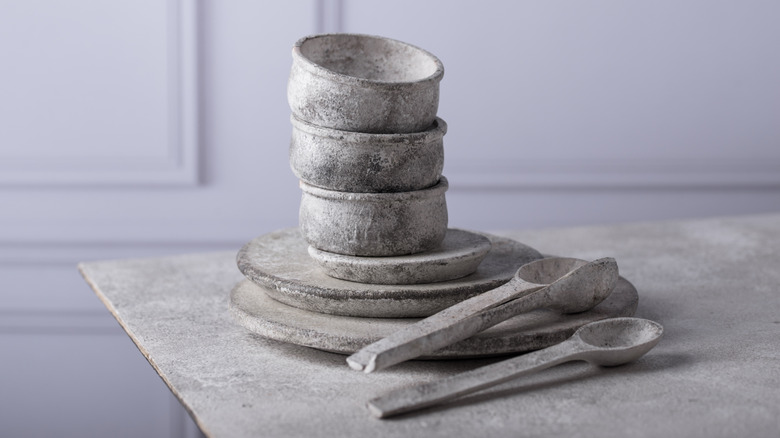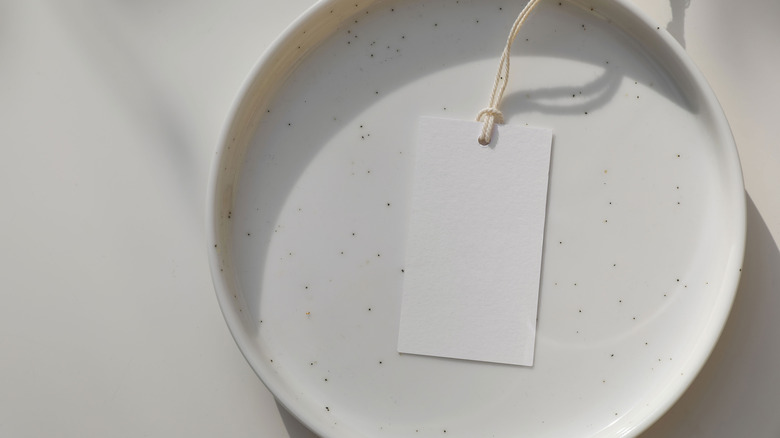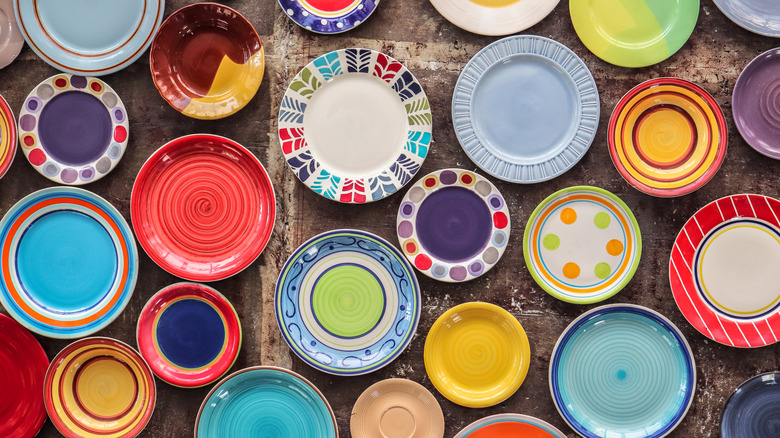11 Things To Consider Before Buying Dishware From Costco
Dishware is truly a must-have for every household. Not only are dishes necessary tools, but they also play an important role in establishing the atmosphere at the dining table. But if your mealtime setting is starting to show the telltale signs of wear and tear, such as scratches, chips, or cracks, then it may be time to consider purchasing a new dishware set. And there may be no better place to refresh your dinnerware than at Costco, a store known for its affordable pricing on everything from groceries to toilet paper.
The process of shopping for dishware shouldn't be taken lightly, though, as you'll need to consider several factors before barreling into the much-loved warehouse chain and grabbing the first set that looks suitable. For example, discreet features that are easily overlooked by unprepared shoppers — such as plate color or weight – can affect the perception of a meal in more ways than one. So, before grabbing the most eye-catching or inexpensive kit, take a moment to consider the needs of your household and kitchen. This will ensure the dishware purchased both suits the needs of the family unit and becomes a captivating piece of the kitchen.
Determine which dishes are used most in your kitchen
Dishware sets at Costco, even when offered in the same size and material, will often include different dishes. For example, two separate 40-piece bone china sets could include a variety of items, including salad plates, different sizes of bowls, and even tea cups and saucers. The common denominator here will typically be a dinner plate (which isn't a shock, considering this is the most used plate during a meal), but which items your kitchen needs most will heavily depend on the habits and preferences of your household.
Perhaps bowls are heavily preferred to plates. Or maybe the last time a teacup was used by the occupants of your house was during afternoon tea at the fancy restaurant down the street, and the item just isn't necessary for your lifestyle. Along those lines, it's useful to take notice of what your house could use more of. For example, you may have more than enough dinner plates, but every Tuesday during spaghetti night, pasta bowls are in short supply. With this in mind, before heading out on a shopping adventure, take a peek around the kitchen and consider which plates are your go-tos and which you could easily go without. Narrowing this down will help you avoid overwhelm when faced with so much variety in the Costco Home & Kitchen department.
Take the size of your household into account
This might seem like a more obvious tip, but the size of the household will determine how much dinnerware is needed. A family of 10 will certainly need more plateware on a daily basis than a family of two. The last thing a shopper would want is to impulse buy a lovely 40-piece dishware set when there are only two dishes needed on the table each night. Likewise, a family of 10 would hate to grab a 16-piece dining set, only to realize they will need to run the dishwasher constantly to have clean dishes.
Luckily, Costco offers widely varying sizes of dishware sets to accommodate all families, ranging from 12-piece sets (recommended for families of four) to 40-piece sets (recommended for families of eight). Normally, this information can be found on the box, or if purchasing on the Costco website, the information is typically listed in the "Features" section. A good rule of thumb for plateware is that for each person in the household, at least two complete sets of dishware should be available. This avoids panicked dishwashing before meals and will ensure there are more than enough dishes available for those sitting down to dine.
Know which material you prefer your dinnerware to be made out of
A wide range of materials can be used to craft dishware, each sporting a unique range of pros and cons. Some of the most common types of dishware found at Costco are bone china, stoneware, and porcelain. Bone china and porcelain are often mentioned in conjunction as they share nearly the same ingredients, with the exception of cow bone ash, which is added to bone china (and which solves the mystery of where it gets its name from). As the bone ash strengthens the dishes, bone china sets are able to be thinner without losing durability, often appearing elegant. Porcelain, on the other hand, is often used for other kitchen items such as bakeware due to its elevated ability to handle high temperatures.
Stoneware has a different creation process, where mineral-rich clay is fired at extremely hot temperatures. Thanks to the way it is made, stoneware is known for its ability to retain heat for a longer time, though these dishes are considered thicker and heavier than porcelain and bone china dishware. The final product is often considered to be rustic, fitting right in with calming earth tones and wooden accents. Each of these materials has its own pros and cons list, so you should take some time to research which material will best fit your household's needs.
If your ideal set doesn't match the one at home, don't sweat it
At this point in the shopping process, after thinking through the previous considerations, some shoppers may already have their eye on a certain Costco set, which is fantastic. But does your new prospective set match the old one sitting in your cupboard at home? If there's a mismatch, shoppers may feel compelled to get rid of the previous dishes, but there's really no need to ditch the old dishware or worry if the colors or style don't match the new set. In fact, even interior designers set the table using mismatched platewear, mentioning that it makes for a more fascinating meal when different sets are combined in unique ways. Enjoy the fun of experimenting with different color and shape combinations at the table.
That said, following some basic pointers will keep your dining table looking its best. For one, decide how formal an affair you're hosting. If ornate bone china is being placed on the table, for example, you probably don't want to use plastic utensils. Additionally, choosing a color scheme will help avoid color clashes, while mixing smooth and rough patterns can add some texture to the table. There are countless ways to turn a mismatched dining set into a beautiful dining table spread with a little finagling.
Determine whether durability is a primary concern
Before committing to a dining set, it's important to consider how durable you need your dishes to be. If purchasing a set that will be used several times a day, or used by children who may not take the necessary caution to avoid chips or breaks, investing in a highly durable set would likely be ideal. If the set will be less frequently used, perhaps only pulled out for fancy magazine-esque dinner parties or special occasions, durability may not be as big a factor. Costco often will rotate stock based on seasonal or price considerations, which means there is no guarantee a replacement will be easily found if breaks do happen. Keep in mind, true durability means that the dishware will stand the test of time, not just that it won't break immediately the first time it crashes to the floor. That's why taking the time to consider the durability of potential sets will save a purchaser time and money in the long run.
Of the three most common dishware sets found at Costco, bone china is widely considered to be the most durable due to the addition of cow bone ash in the crafting process. Although the sets often appear to be more on the elegant and delicate side, this look is nothing but a facade. The least durable of the three is considered stonewear, though not by much. Stoneware is fired at a lower heat than porcelain and does not have the added durability from bone ash that bone china has, which means stoneware dishes may chip and crack more easily.
The weight of your dishware can add to the dining experience
Based on the information shared so far, with bone china and porcelain being top contenders for durability, it would be easy to overlook the allure of stoneware. But before crossing stoneware off your list of options, consider how dish weight may affect a meal. As the heaviest option of the three, stoneware is a strong contender if meal perception and heat retention are important to you. Based on a 2015 study done by Flavour Journal, heavier cutlery was found to positively influence the willingness of customers to pay for the meal, as well as to improve the perception of meal's quality. In light of this research, it wouldn't be a far stretch that these findings would apply to the weight of dishware as well. Thicker plates also have the ability to hold heat for longer periods than thinner options, such as bone china.
Of course, with weightier dishware, there are some drawbacks. A heavier plate will create a larger impact when accidentally dropped on the floor, and carrying a stack of plates will be more physically challenging, which may not work well for your household. If little ones are scampering about the house or helping to set the dinner table, for example, a lighter option might be better.
Consider whether you'll put your dishes in the microwave, dishwasher, or oven
Appliances like the microwave, the oven, and the dishwasher are part of everyday life for many people. They are so run-of-the-mill in today's society that consumers frequently forget to check whether their dishes can be used with these appliances, especially with so many other elements to consider when purchasing tableware. This doesn't mean they aren't vital, though. If an item is safe to use with an appliance, there will typically be a note on the box or package stating this. On the Costco website, there is sometimes a specific flag for these things under the "Specifications" description on an item. To the right of the "Cleaning Recommendation" heading, there should be a note saying that it's dishwasher safe, while beside the "Features" heading, it will be noted whether the dishware is microwave safe. If these flags are not listed, take a look in the "Product Description" section, as occasionally these details are listed there instead.
The oven-safe element is less popular but just as important, depending on your cooking style. Oven-safe dishware can withstand the high temperatures of an oven without breaking, an option for those who enjoy a seamless baking-to-serving experience. For example, with oven-safe dishware, an individual could cook the item in the oven on the same plate that it is then served on minutes later. This could come in handy when roasting vegetables or chicken thighs. Costco does offer a smaller selection of oven-safe dishware — this information can also be found in either the "Specifications" or the "Product Details" sections.
Setting a budget will help you keep realistic expectations
Before picking up the dishware set that dreams are made of and gasping in shock at the price, setting a realistic budget for the amount spent on the purchase will help keep shoppers on track. Despite Costco's trademark low prices, high-quality dinnerware sets can still cost a pretty penny. Planning for even a broad estimate of what will be spent will help keep spending in line with expectations, eliminating the allure of impulse buying. Simple differences like the material used, whether the item was mass-produced or handmade, and, of course, the set size will heavily determine the cost of a plateware set.
Bone china is the most expensive, as creating a set requires expensive materials combined with a labor-intensive process. The price of bone china also depends on the percentage of bone ash included in the recipe, with a higher percentage equaling a heftier price point. Stoneware, on the other hand, is often easy on the wallet, as it uses lower-cost materials and a less complicated firing process. Also, keep an eye out for words like handcrafted, or the country the set was imported from, as this may result in a price difference. For example, a handmade porcelain set created in Derbyshire, England, is certainly going to be a talking point at the dinner table, but the price is going to be far beyond what a mass-produced porcelain set made in China would cost.
Consider the impact color can have while eating
It may at first seem like hokum, but research has suggested that something as simple as the color of a plate can affect diners' perceptions of portion sizes. Studies have shown that the more contrast food has with the color of a plate, the smaller the portion sizes appear. Alternatively, the less contrast between the plate and food colors, the bigger a portion size seems, such as serving rice on a white plate. This phenomenon is so widely observed, it has actually been coined the Delboeuf illusion.
Additionally, there is research suggesting that the color of a plate or cup can influence taste perceptions and even appetite in general. Food is regarded as sweeter when served on a white plate, while a black plate can make food taste more savory. Red plates and blue plates have been known to tone down appetites and are often recommended for people who are dieting, as they lead eaters to consume smaller portions during meals. Yellow plates have the opposite effect, encouraging table occupants to eat more. With all this in mind, pausing to consider which of these outcomes is the most desired during mealtimes is crucial before snagging just any color combination.
Know which size of plate, cup, and bowl works best for the household
As previously mentioned, sets differ in the items they include; however, they also differ in the sizes of the items included. When looking at the stock photos of dishware sets, this consideration might not be immediately noticeable, but there are several different sizes of plates, mugs, and bowls to choose from. Two separate sets may both include mugs, but one mug may have a capacity of 10 ounces, while the other boasts a 17-ounce maximum. Even plates, the most basic dish, will come in different sizes, with most of the ones available at Costco between 10 and 11 inches wide.
This is why, before examining the options for dishware sets at Costco, measuring the size of the dinner table and the cabinet space available can be vital. If the dishes selected are too large, your dinner table will end up looking cluttered. Even if the dishware is the correct size for the table, if it is too large to fit properly in the cabinet, this could cause stacking and storage issues. For example, a mug holding 17 ounces may be taller in height than a 10-ounce one, and may not fit in the space between shelves. Improper stacking can lead to dishes chipping or even breaking, so considering this could even help prolong the life of a dish set.
Don't forget to use one of the most important tools at hand, the reviews
Sometimes the best source of information comes from someone who has actually experienced the product firsthand. Before pulling the trigger, take a peek at the reviews on the Costco website to see if there are any recurring experiences. This can yield some valuable insight, potentially saving you from the hassle of a plate that is easily chipped or that gets scratched on the first night of using it.
Looking at just the star rating itself will give customers a general idea of what to expect from the purchase, but clicking into the text of the review to really narrow down what people are liking and disliking about the product is even more helpful. For example, a one-star review clearly shows the reviewer did not have a positive experience, but occasionally the rating will be based on a factor outside of Costco's control, such as their delivery experience.
